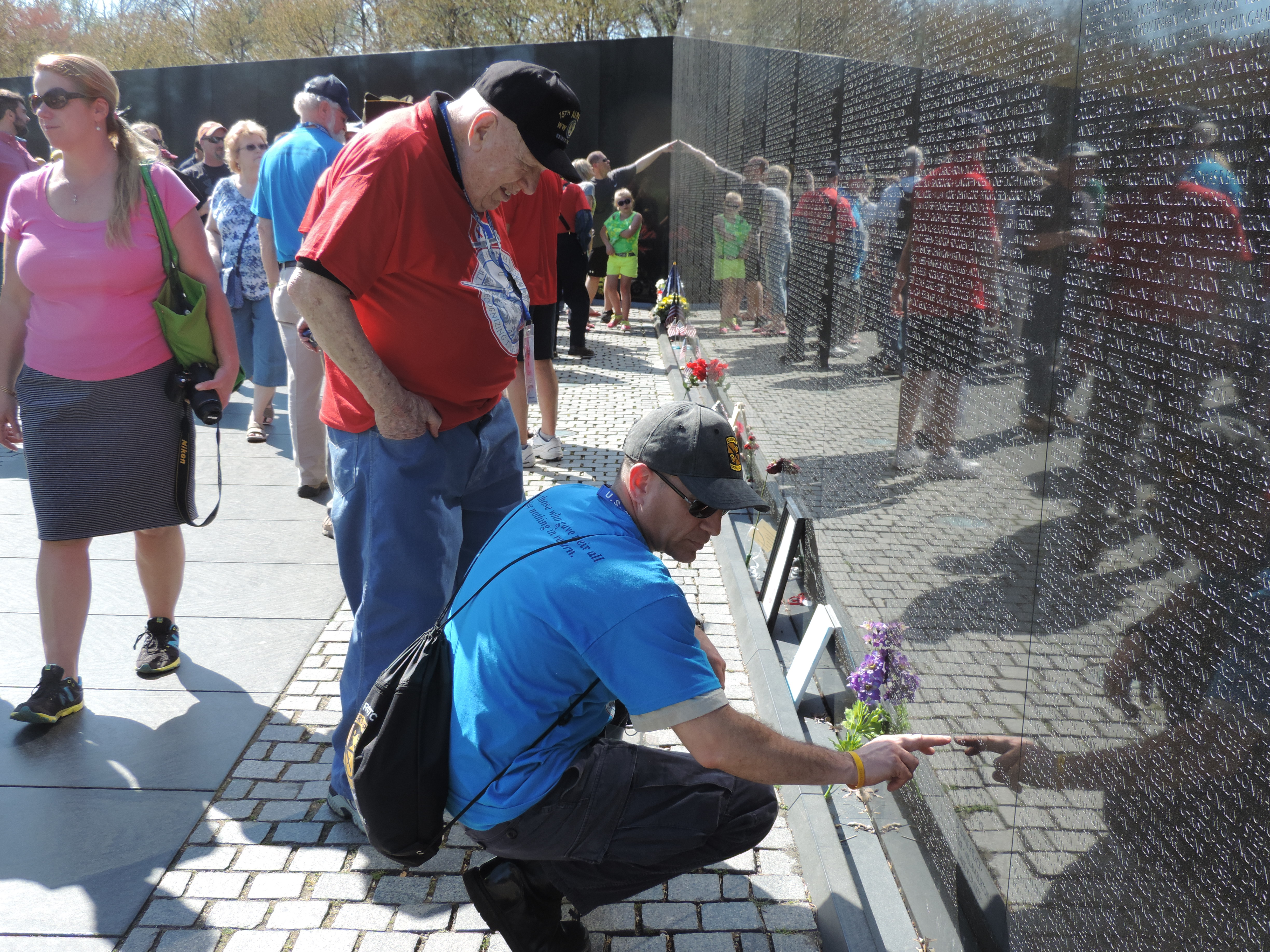
Visitors pause at The Three Soldiers sculpture, part of the Vietnam Veterans Memorial in Washington, D.C. Apalachin native, Bernard Bailey, was a project manager on the memorial construction, which included the erection of Frederick Hart’s sculpture. (2014 Photo by JoAnn R. Walter)

Visitors pause to find a soldier’s name at the Vietnam Veterans Memorial in Washington, D.C. Apalachin native, Bernard Bailey, was a project manager on the memorial construction, which included the addition of pavers, night lights, bronze name locators, and adding new names, retrospectively. (2014 Photo by JoAnn R. Walter)
According to the National Park Service, approximately three million guests visit the Vietnam Veterans Memorial, in Washington, D.C. each year. Consisting of the Vietnam Veterans Memorial Wall, the Three Soldiers statue and the Vietnam Women’s Memorial, it honors the U.S. Armed Forces who fought in the Vietnam War, those who died in Vietnam and Southeast Asia, and for those Missing in Action.
When visitors look at the names engraved on the Wall, his or her reflection can be seen at the same time, which is a significant symbolism of its design. The Three Soldiers, a bronze statue which complements the Vietnam Veterans Memorial Wall, is positioned in such a way to interact with the Wall, as if the soldiers are looking on in tribute at the names of the fallen.
Located in Constitution Gardens adjacent to the National Mall, the main part of the memorial, designed by American architect Maya Lin, was dedicated on Veterans Day in 1982. Before ground broke in March 1982, political and public controversy erupted over the design. James Watt, then Secretary of the Interior under President Ronald Reagan, initially refused to agree to a building permit because of the intense outcry. Eventually, a compromise was reached which added Frederick Hart’s life-size, bronze figurative sculpture of three soldiers, subsequently dedicated in 1984. The Vietnam Women’s Memorial was dedicated in 1993.

Apalachin native, Bernard Bailey, 1971 OFA graduate and 1975 Naval Academy graduate and Vietnam-era veteran, was a project manager on the Vietnam Veterans Memorial construction. (Provided photo)
Former Apalachin, N.Y. resident, Bernard Bailey, a 1971 Owego Free Academy graduate and 1975 Naval Academy graduate and Vietnam-Era veteran, became involved in the new phase construction in 1983. Serving for eight years as a naval officer and after his release from active duty, Bailey’s first civilian position was working in Washington, D.C. as a project manager for Gilbane Building Company.
Bailey was assigned by Gilbane to ensure that additional work was completed on the Vietnam Memorial. The erection of Frederick Hart’s sculpture and the placement of the American Flag and service ring around the flag, adding lights for evening visitors and expanding pavers to accommodate the large volume of visitors were all part of the project. Bronze name locators to assist visitors in finding names listed on the Wall were a significant feature, as was adding new names to the Wall retrospectively.
Arriving for work at sunrise every morning on the Washington Mall gave Bailey a unique perspective. He explained, “The Memorial is a beautiful and inspiring monument. Its strength, power, and solemnity can only be appreciated by seeing one’s own reflection amongst the names of the 58,300 service members who lost their lives.”
As a midshipman, Bailey experienced anti-war attitude, including public scorn or ridicule if seen outside the Academy gates in uniform. He shared an example of one occasion when he walked by an Annapolis establishment that had a posted sign that read, “No dogs or midshipman allowed.” Later deployed for a time period, which took him to Subic Bay and Hong Kong, Bailey’s ship, the U.S.S. Dubuque, cruised through international waters that were part of the Vietnam “war zone.”
Bailey shared, “While this experience did not compare to actually being in the battle zone, it did provide me with an appreciation for the hardships suffered by our sailors and marines.”
Bernard Bailey is the son of the late “Bud” Bailey and brother of Tom Bailey of “Bud’s Place” in Apalachin. Today, Dr. Bernard Bailey is Chairman and C.E.O. of Authentix, Inc., a global leader in authentication solutions, based in Addison, Texas. His career spans over three decades with management experience in the high technology and security industries. He holds advanced graduate degrees in engineering from UC-Berkeley and USC, an MBA from George Washington University and a PhD in Management from Case Western Reserve University, and is a certified Professional Engineer in the Commonwealth of Virginia.
Now more than 30 years since his involvement with the Vietnam Veterans Memorial, Bailey said, “Going to work on the Memorial every morning, I saw how this war so deeply scarred many Americans. I have a deep sense of pride knowing that I played a small role in helping bring dignity to the service members who sacrificed so much.”


